Please find here the citable pdf version of the article
On Thursday, 23rd April 2015, I returned in the early morning hours to the Asian Development Bank (ADB) biochar project in Nepal. Excellent summer weather made it an enjoyable day seeing our team and having meetings at various places in downtown Kathmandu. On Friday morning Bishnu Hari Pandit and I traveled in an old Nissan Jeep to the hillside village of Dunkharka, some 35 km outside of the capital, to visit with our local Biochar Farmer Group and check in on the biochar trials set-up with tomato plants, where the combined effect of biochar and cow urine is being investigated.
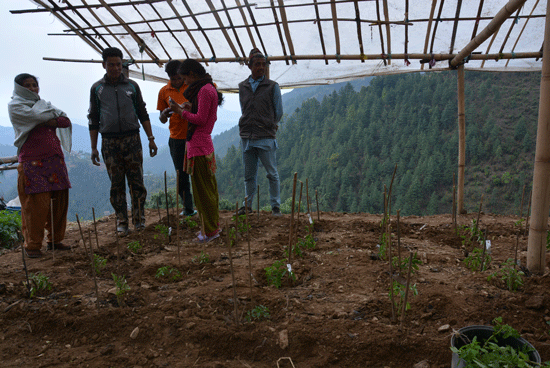
Photo made in the afternoon before the earthquake in Dunkharka after finishing the set-up of this tomato field trial comparing cow urine enriched biochar + compost with cow urine + compost, biochar + compost and control with compost only (N=5).
At Susan Shresta’s farm (see picture above) we set-up a new scientific trial comparing the effect of compost, biochar-compost, compost mixed with cow urine and urine-charged biochar mixed with compost. Most of the 11 farmers and some of their children helped in the installment of the trial which is always quite challenging to make sure that none of the many hands mixes up a treatment or runs over a preparation or exchanges labels. After a communal lunch (Dal-Bath as always), it started to rain and became unexpectedly bitter cold for the end of April, instead of the drought and peak temperatures that would be normal for this time of the year. We nevertheless continued to check on a good half of the 11 Farmer trials established during our previous visit.
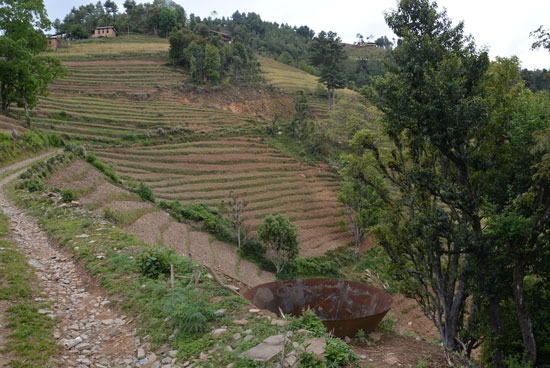
Notice the village Kon-Tiki in the middle of steep terraces where mostly corn is grown at this time of the year. The corn stalks will be transformed into biochar after the rainy season in September.
The next morning was Saturday April 25th, 2015. Before dawn I ascended a beautiful hill where on good days Mt. Everest, Makalu, Lang Tang and many other secondary summits of the high Himalayans can be seen. However, it was drizzling this morning and fog banks were drifting through the forest. After morning tea we visited the trials of other farmers and accidentally happened upon a fire ritual being held in a Hindu temple (using an Agnihotra which is similar to the soil pit Kon-Tiki). After a final tea with the local farmer leader of the biochar group, we said Namaste to our friends just before noon. We headed with the old Nissan for the steep forest stony road back down to the valley to reach the next Biochar Farmer Group.
When we came out of the forest that protected us, unaware, for twenty fatal minutes, we learned that at 11:57 am the earthquake had destroyed most of the houses on the ridge top of the village of Dunkharka. Fortunately all our farmers survived though that was only confirmed several hours later.
For years, all those engaged in development work in Nepal lived in fear and terror of the outbreak of ‘the big one’. It was impossible to walk through the old villages without anxiously noticing the rickety houses and countless people in the narrow streets. Everyone knew that a major earthquake was likely to come at any time and yet desperately hoped that it would not because of the unfathomable inactivity of successive governments and the country’s population to adapt the building policy and take measures to prepare for such a disaster.
Although it may seem outrageous to say, it was incomprehensibly lucky and perhaps a sign of the gods, that the quake happened at noon on a holiday and not at night or on a school day, and even luckier that it wasn’t even stronger.
In Europe, my family learned much earlier and much more about the extent of the disaster than the more than 30 million of us in the country who received only rumors and no official information. We had to rely on eyewitness accounts from friends and relatives that we were able to reach by phone before cell phone batteries were empty and could not be recharged. However, eyewitness reports were more accurate than the sensational news that the media allowed to filter in.
Twenty minutes after the falling down of so many houses and the burying of whole villages beneath landslides and rock avalanches, we were standing safe in a meadow still feeling the earth trembling from aftershocks under our soles, some 30 km east of Kathmandu. It made no sense to drive back into town. Not really knowing where to go to, we left the meadow and headed for the next Farmer Group in Baghundu Besi, a neighboring valley 30 km southeast. Fortunately the situation there was a bit more stable. Although barely a single house remained intact and the earth continued to shake several times an hour, all people in the vicinity were unharmed. The houses seemed repairable. At night, of course, no one slept inside.. Makeshift tents were built in the open fields, families and neighbors coming together, sharing their meal and drinks. More than 20 million people sleeping outside Saturday night and at least the three following nights without any reported trouble except for the continuous swaying of the earth with after shakes. Not a single media outlet mentioned the beauty of these people jointly and peacefully overcoming the disaster. This is one of the reasons we love this country so much and are committed to helping in this difficult time of natural and governmental catastrophe.
The next morning we attempted to return to Kathmandu. Our Jeep was one of the few cars on the otherwise empty road into the city. Very scary atmosphere with houses cracked and partly fallen down, people shocked in the streets. When we came upon a wide crack in the asphalt where the road had sagged just at the entrance of the city, we decided to just go back to where we’d come from earlier, opting for the safer way out. What help with only our bare hands and no information would we have been amidst the million people in the crowded city? If we could be of help, we thought, then it would be through communication and planned action.
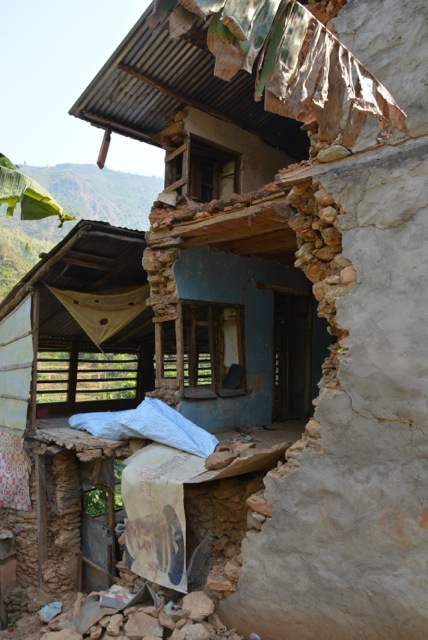
The house of our farmer leader in Dhading.
We drove through the continued quivering of the foothills to the south. At Neupanetar the strong 6.7 aftershock released a rockslide blocking the bridge to Dolakha. Finally, south of Sindhulimadi the situation became more reassuring, No more crushed houses were to be seen, and eventually no more cracked walls were visible from the road. Once in the flatlands of Terai, there was even occasionally electricity, so we could charge the phones again.
Bishnu telephoned almost continuously. Thankfully his family was unharmed; soon we also knew that our project team in Kathmandu was safe. We established initial contact with all our 15 biochar farmer groups in as many villages across the eastern half of the country.
Before contact broke off with Dhading and Dolakha completely, the situation was as follows:
Farmer field trials
- Dhading (pumpkin trial): most farmers are safe but we do not have information about all farmers and the current situation, all houses severely impacted, some destroyed, telephone contact on Sunday since then no contact anymore, no electricity or landline phone
- Godhavari (cow feeding trial): situation stable, communication maintained
- Dhunkarka (tomato trial): all farmers are safe, most houses severely impacted, 3 houses destroyed, contact established and maintained
- Baghundu Besi (ginger trial): all farmers are safe, all houses impacted but not destroyed, contact established and maintained
- Naya Gaon (coffee trial): all farmers of the biochar group have survived, 90% of houses are completely destroyed, due to heavy rain and cold, health situation of farmers and their family is critical, contact established and maintained
- Dolakha (potato trial): only one phone call on Saturday right after the earthquake was possible. At his time most farmers had survived, but not sure if all, most houses had collapsed. Communication reestablished on Friday: Huma Devi Dahal was killed by stone fall on to her house.
- Ilam (tea trial): no damages, farmers are alerted but ok, communication established and maintained
- Udayapur (cinnamon trial): no damages, situation normal, communication established and maintained
- Bara (onion trial): no damages, situation normal, communication established and maintained
- Bandipur (chili trial): all farmers are safe, houses of network farmers damaged but standing, contact established and maintained
- Dumre (goat trial): farmer family safe, goat shed crashed, trial cannot be continued, initial communication after the disaster was established but farmer currently not available
- Lamjung (banana trial): all farmers are safe, houses of network farmers partly to severely damaged but standing, contact established and maintained
We discussed most of the time in the car and later when we were in Southern Nepal how we could best help in the short, medium and long term. Initially we thought about setting up a donation fund to help finance the reconstruction and repair of houses for “our” farmer families. This idea was of course the obvious one, but the more we thought about it, we realized how much this would only foment discord within the community. We cannot pay for the reconstruction of all houses, but what right do we have to help one family and not another in a given community? We also believe that it does not help to just rebuild the same style of fragile clay houses before rethinking the construction design to build structures that can better withstand future quakes.
We had to find a different, more progressive solution to support our farmers to build a more sustainable and safer future for them and their villages. We decided that our support should be in the field of our expertise: in agriculture, nutrient recycling and climate farming strategies that were the reason for our collaboration in the first place.
A novel idea finally dawned on us, an alternative to straightforward reconstruction aid (which fortunately already comes from many other sources including state-directed aid for farmers). Instead of collecting donations targeting for rebuilding houses, we began to develop the concept of setting up a climate fund for Nepal, which would enable long-term food security, income security and could ensure a more balanced natural resource distribution.
Last year we showed all 15 biochar farmer groups including 120 farmer families, how they themselves can produce biochar with the Kon-Tiki technology and how biochar can be used as a soil conditioner within their existing farming practices including animal husbandry. Gradually, the results of these tests have been coming in and confirm the potential of using organically enriched biochar for a variety of crops (the results from tests with pumpkins, potatoes, onions, bananas, coffee, tea, chili, cinnamon, corn, barley and a number of other crops will be shared shortly by Ithaka). Despite the various positive results using biochar, its large scale implementation will prevail more slowly as some common practices have to be changed and shifting from a dependency on chemical fertilizers to a more organic system is not to be done from one season to the next especially as farmers are traditionally very reticent towards all change that might imply more work than rather less in the beginning.
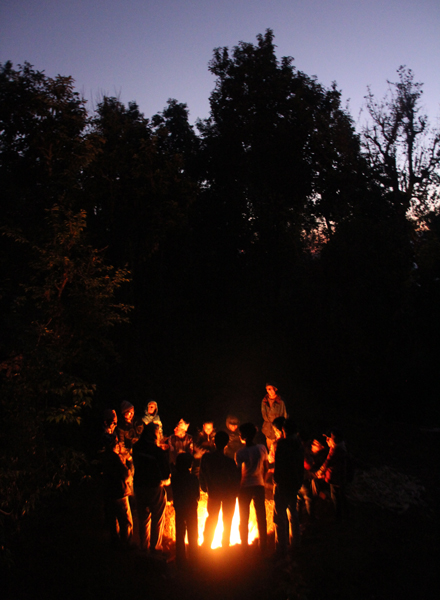
Farmer biochar production in Dolakha weeks back on a happier day.
And so, here is our proposal for those looking to help Nepali farmer families for the mid to long term:
If Nepali farmers could sell for each cubic meter of urine enriched biochar that they produce and apply to their fields a CO2-certificate corresponding to the amount of sequestered carbon, the use of biochar would become economically viable for them even without accounting for the benefits they can obtain through higher yields and lower chemical fertilizer costs. All actual benefits of biochar would thus become an additional income bonus for participating farmers. This type of program would enable faster adaptation of climate farming techniques than the current approach which is to convince them through words and by slowly building-up their own practical experience over several seasons.
We propose a modest price (for western life styles) of US$20/t of CO2e for each carbon certificate. Selling carbon certificates at this rate the average Nepali farmer could earn about 14.400 rupees (the equivalent of 2 months wages) per half hectare of intensive vegetable production assuming 300 g of urine enriched biochar per m2 is applied twice a year
Our calculation is based of the following assumption: (1) An average carbon content of 68% for mixed feedstock containing maize stalks, bamboo, rice husks and straw, eupatorium forest killer shrubs, twigs, sugar cane, coffee, tea and cinnamon prunings, banana trunks, and the like. (2) Six tons of biochar per hectare and year equals 3.9 t of carbon. (3) 3.9 tons of sequestered carbon is the equivalent of 14.3 t of CO2.
The average Nepali farm is very small, measuring about one half hectare. The amount of biochar which could realistically be produced, charged with animal or/and human urine and put to use twice a year (once for each crop) on this amount of land is about 3 tons. An average farmer family might thus sequester the equivalent of 7.1 t of CO2e. Selling 7.1 t of CO2e-certificates to the Nepali Climate Farming Fund at US$20 per ton equates to 14,400 NRP (US$142). This would compensate farmers for the numerous hours required for feedstock collection, charring, urine collection, biochar nutrient enhancement and application in soils.
Using the Kon-Tiki kilns already installed in all 15 villages during our previous visits, farmers can produce biochar virtually for free from the abundant waste materials. To charge the biochar with nutrients, farmers collect the urine of their cows and if possible, also from the family, rather than allowing both to run down the mountains unused. Each cow generates 55 kg of liquid nitrogen per year, exactly the amount needed to fertilize nearly half of the average farmed land. The collected urine is then used to quench the biochar in the Kon-Tiki and to produce highly efficient organic biochar-fertilizer slurry. Replacing 110 kg mineral N fertilizer per half hectare and avoiding emissions from liquid animal manure reduces CO2e emissions further by approximately 1.2 t CO2e (Zhang et al., 2013), which is not yet included in the above calculation. Additional not yet included beneficial climate effects are the potential increase in soil organic mater and the emissions reduction when harvest residues are charred instead of burned in the open fields which is common practice in Nepal as in many Asian countries.
Every farmer family that receives money for biochar related climate certificates from the Nepal Climate Farming Fund will be required to reach out to at least one neighbor family to recruit and instruct them in the art of char-making and nutrient enhancement, so that they too can begin to include biochar in their economic cycle and become eligible for selling carbon credits.
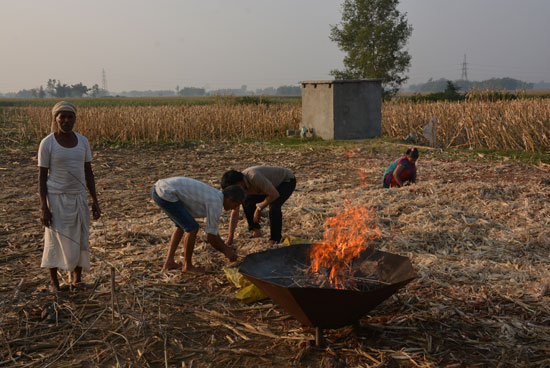
Charred maize stalks in just harvested maize field in Bara, Terai.
Our Ithaka team in Nepal is prepared to launch this fund and to organize it transparently for the benefit of farmers. In exchange for your support, you will not only receive a CO2 emission offset, but you will know exactly which farmers you are helping to build resilient soils and to close the nutrient cycle. We started planning a transparent and efficient system for small farmer carbon credits using a GIS system to locate and monitor every biochar application of each farmer. Via smartphone app (at least every lead farmer has such a device) the GIS data as well as three photos of the application mode and amount will be transferred to our web system. Each carbon credit that someone purchases will thus be directly and personally linked to a farmer family and their field. The buyer will know for each ton of CO2 that he compensates which farmer family applied where and how much biochar.
To further develop this program we are collaborating with the Nepal Agroforestry Foundation (NAF). NAF initiated the planting of 20 million trees in farmer fields across the country over the past several years. We plan to increasingly integrate the agroforestry plantations with the application of 10 to 15 kg of nutrient enhanced biochar around the roots of each planted tree to foster its growth and increase plant survival. We will thus enable that not only biochar carbon will be sequestered but more importantly new tree growth will accumulate more carbon in its biomass and roots in the surrounding soil.
If you, dear readers and friends of Ithaka believe that we can help farmers to improve their standard of living for the long-term in this way, I ask you, from the bottom of my heart, to donate to the Nepal Climate Farming Fund. Please send your donation (tax deductible in Europe) through our website or transfer the amount directly either to our German account:
Ithaka Institut, Postbank München
IBAN: DE84 7001 0080 0035 7358 08
BIC PBNKDEFF
or to our bank account in Nepal:
Nepal Investment Bank
P.O.box 3412, Lalithpur
Account Holder: Bishnu Hari Pandit
Account: 00405010089907
Swift: NIBLNPKT
I can personally assure you that 100% of your donation will go to our farming partners in Nepal. Here is your chance to support a truly global biochar community. In no other place of the world than Nepal have so many biochar field trials been created and results shared so freely and openly. Rather than merely alleviating the short term suffering, let’s help Nepal to create a sustainable future and let us learn from their experiences about how to best include biochar once again into common agricultural practice.
Once the acute situation has settled down here in Nepal and I am back at home in Switzerland, a more fully developed concept of the Nepal Climate Farming Fund will be established and communicated. While this fund is initially focused on meeting the immediate short term needs of farmer families through your generous donations, our plan is to transform the Nepali Climate Farming Fund into a transparent carbon credit system where farmers can earn income for building resilient soils by selling carbon certificates through the Climate Farming Fund.
With heartfelt thanks and in commemoration of Huma Devi Dahal from Maina Pokhari (Dolakha)
Hans-Peter Schmidt
PS: Things are moving very quickly on rolling out the Nepal Climate Farming Fund. We are very thankful that in less than a week we’ve collected more than 10,000€ to assist farmers that have been participating in our biochar trials. We’ve already advanced funding for 70 farmer families in exchange for their producing and applying biochar. We will continue to flesh out the details for this program over the next few weeks and appreciate any thoughts or assistance from those with experience rolling out GIS based trading programs.
Please find here the citable pdf version of the article
Literature
Zhang, W.-F., Dou, Z.-X., He, P., Ju, X.-T., Powlson, D., Chadwick, D., Norse, D., Lu, Y.-L., Zhang, Y., Wu, L., Chen, X.-P., Cassman, K.G., Zhang, F.-S., 2013. New technologies reduce greenhouse gas emissions from nitrogenous fertilizer in China. Proc. Natl. Acad. Sci. U. S. A. 110, 8375–8380.

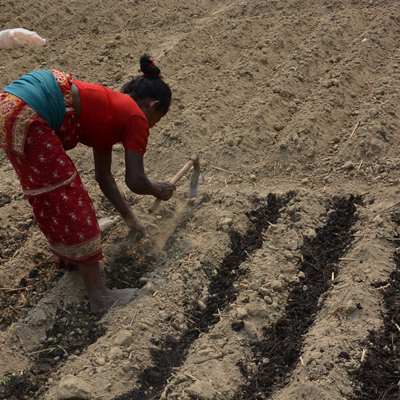
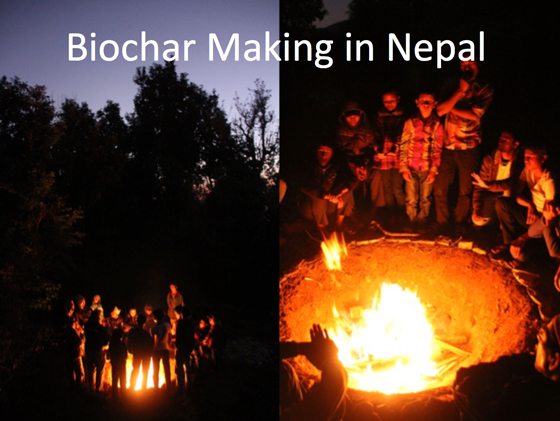
Rust
Noticed the rust on the kon tiki at the corn trial, I have a Pyramid kiln, equally subject to rust and I find it takes very little time to rub oil over it and that stops most rust.